#botryoidal chalcedony
Explore tagged Tumblr posts
Text
If I ever got to wish for anything I would wish for the ability to be able to eat grape agates
#IM GONNA LOSE IT THEY LOOK SO CUTE AND I JUST WANNA GOBBLE THEM UP#i wanna eat it#grape agate#botryoidal chalcedony#they look edible#agate#agate jewelry#crystals#rocks#geology#hyperfixation#food#grape agates#agates#quartz#minerals
18 notes
·
View notes
Note
What is your fav rok
fav rok
g
grape
the one I'm named after
garpe ageta
the ourple ones (the black ones are cool too)
grpae
grape agatate
hlel yeah
31 notes
·
View notes
Text
High Grade Purple & Green Grape Agate / Botryoidal Amethyst Cluster $105 plus shipping.
https://www.oldearthminerals.com/shop/p/high-grade-grape-agate-botryoidal-amethyst-cluster-hpj76-xr77c-2ejhy-z5s87-gm55k
#grapeagate #crystalclustee #botryoidal #grapeagatecluster #mineralspecimens #purpleaesthetic #purplecrystals #crystalaesthetic
#crystals#crystalhealing#minerals#mineralspecimens#mineralspecimen#grape agate#greengrapeagate#Botryoidal chalcedony
14 notes
·
View notes
Text

Natural Grape agate.
Grape agate is a botryoidal variety of chalcedony, distinguished by its clusters of tiny grape-like spheres.
Photo: Naturalstone951
545 notes
·
View notes
Text




Botryoidal Agate -I saw a small botryoidal formation on the back of the rock when I was collecting it. Once the mud was cleaned off, it turned out to be even more beautiful than I expected. The surprises are different after washing.
#agate#fox agate#red agate#botryoidal#chalcedony#collectibles#achat#special collections#gemstones#crystal collection#geology#stone aesthetic#rocks and minerals#natural rock#achate#thunder egg#art of nature#nature lovers
155 notes
·
View notes
Text

Check out this Gorgeous Specimen Botryoidal Chalcedony From Indonesia.
68 notes
·
View notes
Text

Red botryoidal chalcedony from North Ankara, Turkey
Photo:Hasan Kürük
65 notes
·
View notes
Text
Here is a song about my rock collection! It is a tune you probably recognize. Lyrics under the cut!
Permit me to parade my petrological anthology Collected in my quest for comprehensive mineralogy. Their shininess is second to their science and lithology. This song’s about my rock collection! Man, I love geology.
Oh, amethyst is purple ‘cause of iron, isn’t that real neat? And citrine is just amethyst plus lots of geothermal heat. And smoky quartz is brown from radiation and aluminum… Inclusions such as chlorite, rutile, goethite can bloom in ‘em!
(Inclusions such as chlorite, rutile, goethite can bloom in ‘em!) (Inclusions such as chlorite, rutile, goethite can bloom in ‘em!) (Inclusions such as chlorite, rutile, goethite can bloom in bloom in ‘em!)
Oh, sapphire and ruby, well, they’re both corundum chemically And emerald, aquamarine, and morganite are beryl. See, Historically each color had a different etymology And now they’re in my rock collection! Man, I love geology.
(Historically each color had a different etymology) (And now they’re in my rock collection! Man, I love geology.)
My fluorite is a favorite when it’s glowing under UV light. But should it be from Rogerley it changes when the sun is bright. And if you like fluorescence, put this fact inside your cranium: Chalcedony glows green because of ions of uranium!
When making porcelain vases, you need kyanite that’s powdered fine And celestine’s in fireworks and toothpaste such as Sensodyne. There’s mica in your drywall, and the litterbox has zeolites… Your bones and teeth and kidney stones are all hydroxylapatites!
(Your bones and teeth and kidney stones are all hydroxylapatite!) (Your bones and teeth and kidney stones are all hydroxylapatite!) (Your bones and teeth and kidney stones are all hydroxyl-apple-apa-tite!)
When dating strata layers ammonites can be real helpful guys. The sutures in their shell can tell how long ago they fossilized! And artifacts obsidian track trade in archeology. Those ancient folks had rock collections, man I love geology!
(And artifacts obsidian track trade in archeology.) (Those ancient folks had rock collections, man I love geology!)
Oh, did you know that peridot, as super hot peridotite Makes up the planet’s mantle and is also found in meteorites? Which make lechatelierite when it’s sandy soil that they strike. Another form of that is made by lightning, that’s called fulgurite!
Well, garnet makes the best dodecahedrons that you’ve ever seen. Prismatic crystals with three sides are quite unique to tourmaline. A certain mine in Spain produces pyrite that is cubical… Lepidolite can be botryoidal, but that’s quite unusual.
(Lepidolite can be botryoidal, but that’s quite unusual!) (Lepidolite can be botryoidal, but that’s quite unusual!) (Lepidolite can be botryoidal, but that’s quite unusu-usu-al!)
My knowledge of earth sciences is only as an amateur. But hounding and collecting rocks ain’t only for a connoisseur. And for my love of minerals I’m making no apology. Cause rocks are fun for everyone and man, I love geology!
(And for my love of minerals I’m making no apology.) (Cause rocks are fun for everyone and man, I love geology!)
#music#rock collecting#red pen has cool rocks#i am the very model of a modern major general#the pirates of penzance
130 notes
·
View notes
Text
Monday Musings
Let's talk about macrocrystalline quartz vs microcrystalline quartz. I see sooooo many people argue over these in rockhounding groups that I think it is important to address. First, they are the same chemical formula

Whether it's amethyst or chert this is what it is on an atomic level. So, what makes them different?
Well, a big part is how they are formed. Macrocrystalline quartz grows by adding molecules to the surface, layer by layer. It essentially grows in three different environments:
1.) In silica-rich molten rock during cooling and solidification

2.) in pegmatites, during and following pneumatolytic processes

3.) In hot water solutions of silica under various conditions (usually hydrothermal) The water is between 100 and 450 degrees Celsius and often at high pressures. (underground)



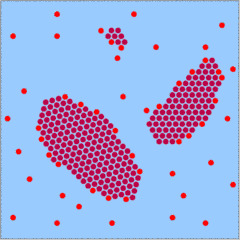

There are no free SiO2 molecules in the solution, instead quartz crystals grow by the addition of dissolved orthosilicic acid (H2SiO4). The four photos above show the process on a very basic level.
In igneous rocks, the formation of quartz is caused by positively and negatively charged ions floating around in the molten rock soup. In fact, these silicate ions cause magmas to become more viscous. SiO4- usually forms long chains in the magma.
When magmas cool rapidly, like at the point of eruption, the chains don't have time to break and new bonds to form so silica-rich magmas often for volcanic glass or pumice.
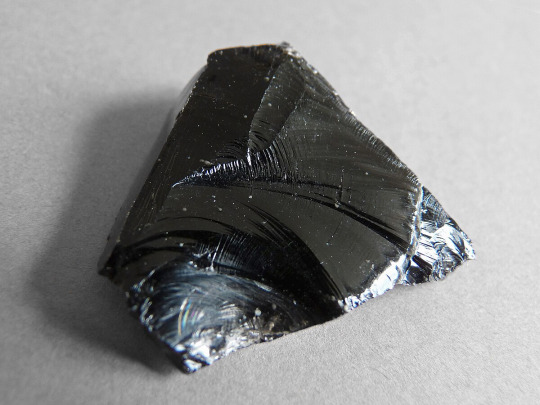
When magmas cool slowly under the surface, like in granite, crystals of different minerals will in the melt in order of chemical composition. With granite, micas form first, the feldspars, then finally quartz. Because quartz is last, it usually doesn't have great shape since it is filling in all available space.
Quartz in magmas will often have an onion-like internal structure of layers added on top of each other reflecting a gradual change in the residual liquid parts of the solidifying magma.
Okay, now for the microcrystalline quartz: chert and chalcedony (and the bazillion names given to different colored varieties of that).
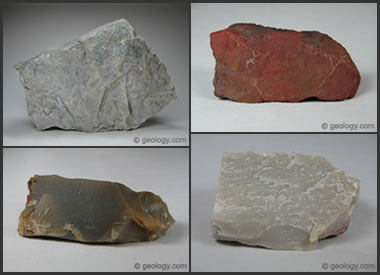
Chert can form under two different processes: biochemical and and replacement through solution in water.
Biochemical chert is formed when siliceous skeletons of marine plankton are dissolved during diagenesis with silica precipitating out from the resulting solution.

Replacement chert forms when other material is replaced by silica usually by water such as petrified wood.

Chert has the same properties as macrocrystalline quartz i.e. same hardness, fracture, etc.
Chalcedony also forms by precipitation of dissolved silica in water but it is usually formed from watery silica gels which give it the botryoidal look it is well-known for.
It is often deposited in cavities and fractures, spaces too small to form proper quartz crystals, by the release of silica from weathering of other rocks (often volcanic in origin).

Isn't quartz wild?
#geology#mineralogy#quartz#chert#chalcedony#science#too many names#formation#igneous rock#silica solution
30 notes
·
View notes
Text
Sorry but I’m gonna smack u all with my ‘tism stick
Have my favourite spider, favourite crystals, favourite poisons and favourite mushrooms

African Black Velvet: eresidae gandanameno sp. “Pretoria” - I want to keep one as a pet, desperately. 10/10 perfect spider.



CHICKEN OF THE WOODS (laetiporus cincinnatus) - if I ever found one of these I would bash my head off a tree in excitement and glee
Fly Agaric (Amanita Muscaria) - I found a few of these while out walking with my uni group 2 years ago and accidentally held up the whole group with a TED Talk. Luckily they were all also mentally ill / autistic /nd art students so I didn’t bore anybody
Ghost Fungus!!!!! (Omphalotus Nidiformis) - if I had the money I would 100000% fly to australia and venture out into the blue mountains at night just to see these beauties bioluminesce.


Vivianite: anyone who brings up crystals around me has probably heard me go “DO YOU KNOW VIVIANITE GROWS OUT OF CORPSES” at some point. It’s a ferrous iron phosphate mineral that grows in a monoclinic crystal system and thrives in anaerobic boggy environments. It forms when the hydroxyapatite in your bones (major source of phosphate) reacts with water from a waterlogged tomb and the iron in any surrounding rocks, resulting in cool shit like blue skeletons and crystals growing out yer teef
Grape Agate: it’s not agate. It’s not chalcedony. It’s not amethyst. It’s a variety of quartz silica which are commonly termed as ‘amethystine’, and instead of taking on the macrocrystalline monoclinic formations typical of normal quartz, it’s made up of up micro crystals that grow radially in a botryoidal form. Also comes in green and white. It’s only found in the Manakarra Beach in Indonesia.



Strychnine: (Strychnos Loganiaceae, Nux Vomica) - the one that leaves you with a hideous grin. It causes violent muscle contractions, enough to make the body bend back to an unnatural degree before the victim finally dies of asphyxiation. Particularly horrid as the victim remains conscious throughout the ordeal and is very much aware of what is happening. In fact, the victim is hyperaware. Nasty stuff. It inhibits your postsynaptic glycine receptors in your spinal cord, which causes the intensely painful and involuntary contortions. Also it’s mentioned in the Herbal of Rufinus as ‘good for helping to balance the phlegmatic and choleric humours’ through purging (vomiting, hence why it’s called the ‘vomiting nut’), and was a medicine to be used with great caution.
Giant Hogweed (Heracleum Apiaceae, Mantegazzianum): all parts of this plant are toxic. man fuck this stuff, if you touch it you’re literally gonna be burning and blistering every time the sun touches your skin for months and possibly even years after coming into contact with this hellspawn plant. Its active constituents are furanocoumarins, which basically mutate your skin cells to become incredibly sensitive to light. It’s a mutagenic and possibly carcinogenic photoactive compound.
Mandrake (Mandragora Officinarum): it’s in the nightshade family (Solanaceae)! Revered in folklore for the way its roots look like a person, said to ‘scream and cause death’ upon being uprooted. It’s a powerful narcotic, hallucinogenic and emetic plant, meaning that you try and eat this shit and you’ll be absolutely off your tits and vomming your guts up before you kick it.
Other honourable mentions that make for interesting reading:
Orpiment, Gasteracantha Cancriformis, Gasteracantha Arcuata, Sugar Fluorite, Jelly Lichens, Monkshood (Aconitum), Bleeding Tooth Fungus, Amorphophallus Titanium
Stupid fact about me: I have, in fact, ingested wormwood (Artemisia Absinthium) to see what sort of effect it would have out of curiosity, but didn’t get very far as it tasted fucking awful (I made a tea). Tastes like nail polish remover, 0/10 do not recommend. Didn’t ingest enough to feel any sort of thujone effect and my little experiment was safely conducted. I did, however, burn some to see if that would do anything and it made me feel rank in the tummy. No hallucinogenic effect. Again. 0/10 do not recommend.
#autism special interest#cw arachnophobia#cw spiders#spiders#arachnophobia#cw poison#poisonous plants#crystals#fungi#mushrooms
9 notes
·
View notes
Note
It's actually so incredibly sweet seeing you talk about your rock-love. You are a consistent ray of sunshine in this place, never stop being who you are 💖✌️
Aww thank you so much!!! As a gift I will tell you about one of my rocks
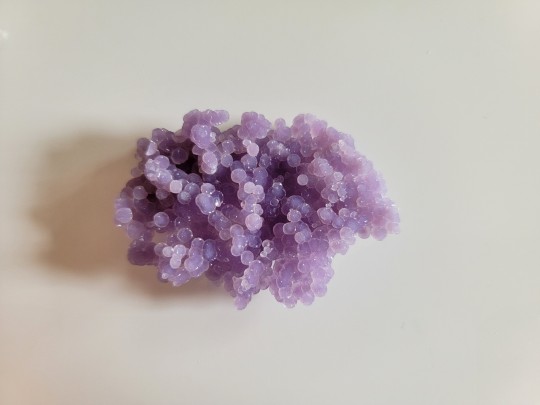
This is grape agate, which both not grapes AND not agate!! Grape agate is the common name for purple botryoidal chalcedony 🥰
Most of it is found in Indonesia, but there's also been small deposits found in Utah, of all places! This piece is from Indonesia. I spent a LONG time searching for a piece that was in my price range and had the vibrant purple color I wanted, since a lot of the cheaper pieces lean very muted purple or blue-ish.
Grape agate forms when andesite lava flows into seawater, leaving air pockets in the andesite as it cools! Water seeps into those pockets over time, picking up minerals and then coalescing into botryiodal (that's the technical term for the sphere formations) chalcedony deposits, aka grape agate! The color in grape agate comes from clay mineral impurities (mostly manganese!)
#bitts answers#rock time#i dont have the energy to talk about mroe than one rock a day lol. lot of typing
16 notes
·
View notes
Text
Friend Toonsonas, Stenographer, HNK Misty, and... Cursed Graham (SUS Jerma)




Can't believe the first Graham drawing I post is just the Jerma SUS face... Anyways. I had the urge to draw Misty as a Houseki No Kuni character though I can't decide what gemstone she'd be. Maybe some sort of Botryoidal mineral or Chalcedony (specifically Grape 'Agate'.)
#houseki no kuni#land of the lustrous#hnk#toontown#toonsona#toontown corporate clash#corporate clash#stenographer#courtney case#misty monsoon#rainmaker#graham ness payser#pacesetter#jerma985
30 notes
·
View notes
Text
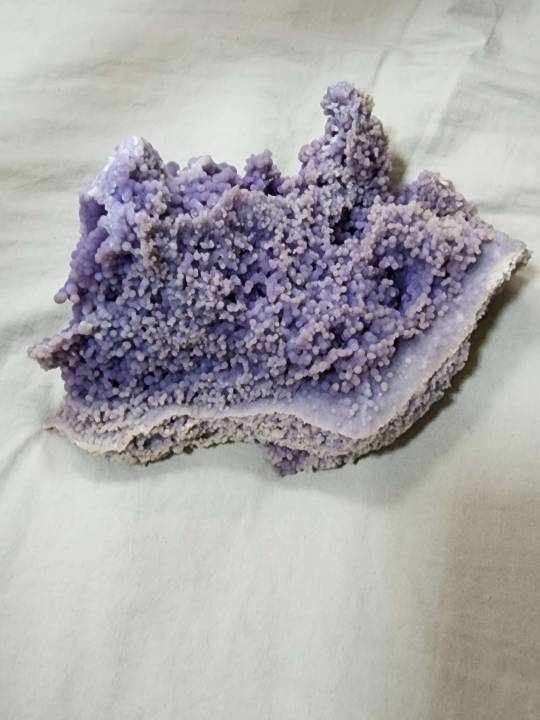
:3
#The 1Kg Grape Agate#grape agate#chalcedony#botryoidal#botryoidal chalcedony#minerals#cool rocks#rocks#geology#blurry picture#I will marry this rock#crystals
26 notes
·
View notes
Text

Grape Agate Cluster
tiny chalcedony crystals with botryoidal habit
Photo: mondszcrystal.id
500 notes
·
View notes
Text



The different colors within the botryoidal structures are fascinating. Botryoidal Chalcedony
#botryoidal agate#chalcedony#carnelian#agate#achat#crystals#special collections#rocks and minerals#crystal collection#geology#crystal#healing crystal#healing crystals#crystal healing#rock shop#collectibles#stone aesthetic#geology rocks#cool rocks#natural life#natural history#gemstones#natural vibes
19 notes
·
View notes
Text
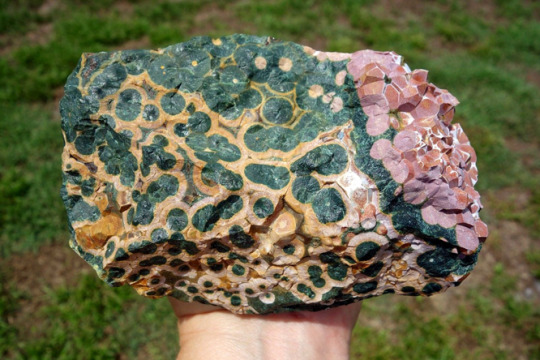
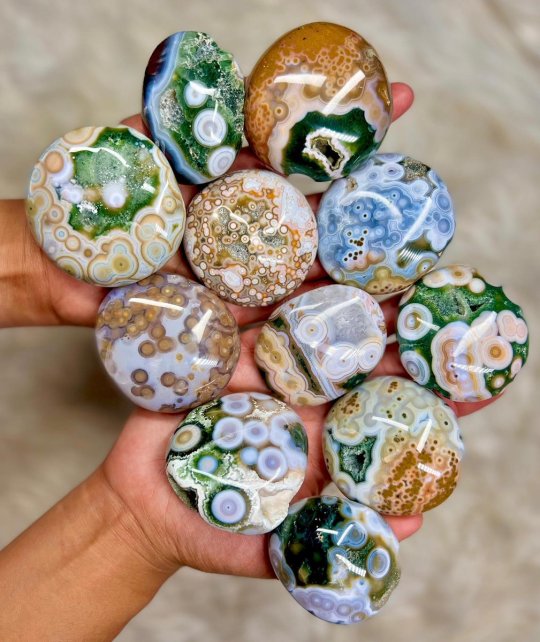
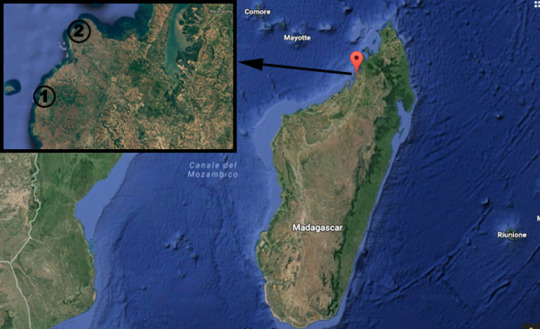
Ocean Jasper, a marketing term for a spherulitic orbicular jasper, a variety which contains coloured orbs or spherical inclusions or zones.
"This new rock has been found along the northwest coast of Madagascar after years of unsuccessful searching. The deposit formed as a rhyolite flow but has been completely silicified. The rhyolitic eyes or orbs come in an astonishing array of colors and color combinations. The background can be white, pink, green, red, or yellow. Botryoidal formations as well as white and deep green druzy are also common. The deposit has been discovered at the edge of the ocean. It can only be seen and collected at low tide. The area has no road so the material must be transported to civilization by boat." (The Lapidary Journal)
The existence of chalcedony deposits in the area was first written about in Alfred Lacroix's Minéralogie de Madagascar published in 1922. However orbicular material is not specifically mentioned. Dr. Klaus Thalheim has documented one of the earliest known examples of Ocean Jasper, a slab from Kabamby. It belonged to Richard Baldauf, an early 20th century German collector.
In 1977 a photo of Kabamby Ocean Jasper was included in Grund's Encyclopédie des Minéraux (Encyclopedia of Minerals), sparking interest in the stone. Ocean Jasper was rediscovered at the turn of the millennium by Paul Obeniche. Like many others, he first saw it in Grund's encyclopedia. Paul launched a series of excursions to locate it. Ocean Jasper was found again in October of 1999, on the shoreline outside the village of Marovato. The original Kabamby material was found nearby later.
Ocean Jasper was introduced to the general public at the Tucson gem show in January of 2000. It was named there by Paul Obeniche and Eugene Mueller. They called it Ocean Jasper because it resembles the waves and ripples of water and the mine was first discovered along the shoreline, originally accessible only at low tide.
27 notes
·
View notes